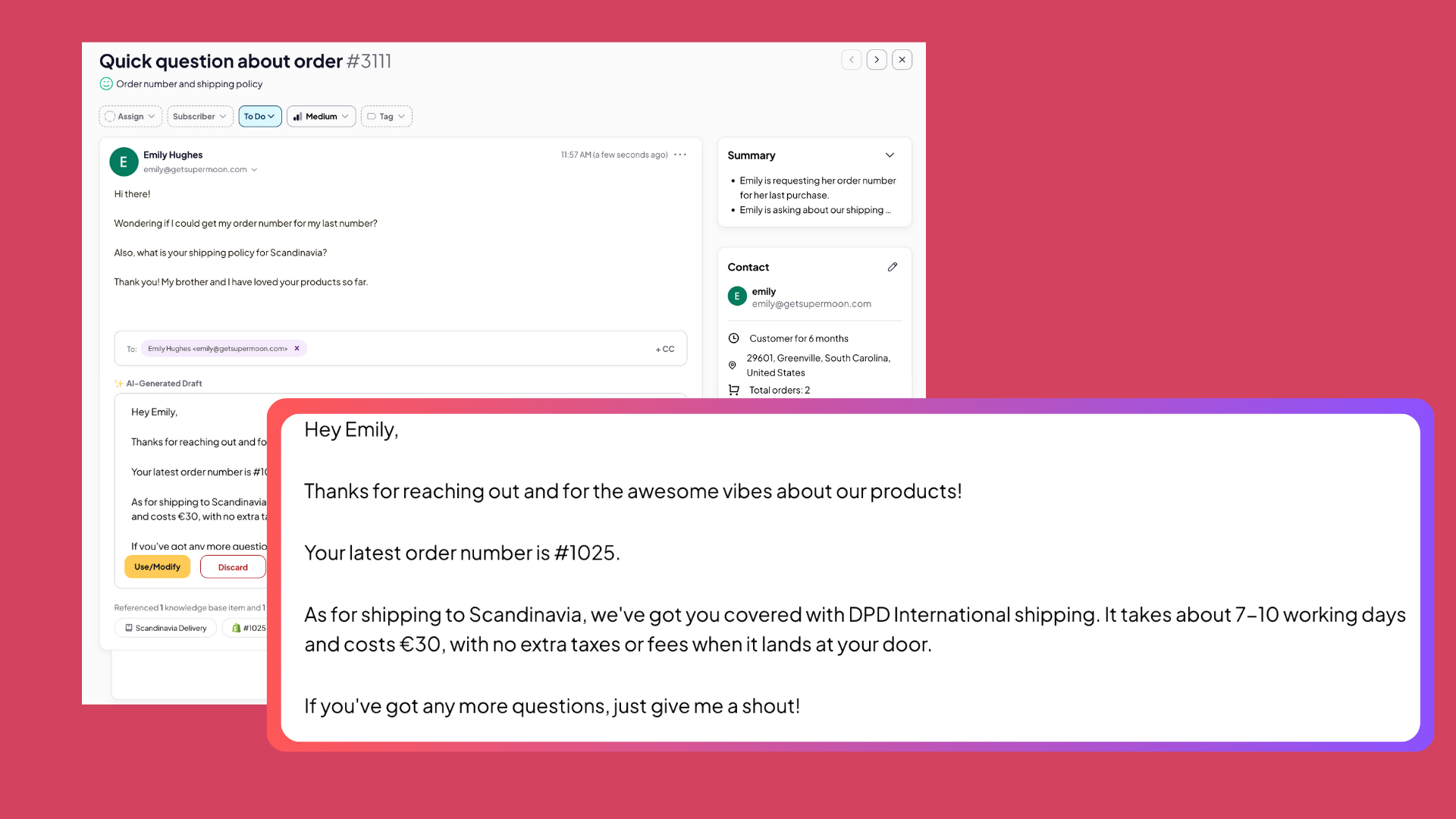From Cart to Retention: Sentiment Analysis in Proactive Customer Service for ecommerce [+ Real-World Examples]
Brands today treat customer support like a fire drill: respond fast, close tickets, and move on to the next one. Meanwhile, the emotional signals (the subtle stuff) go unnoticed. In this post, we’re diving into the strategic role sentiment analysis plays in proactive customer service. We’ll explore why sentiment signals matter more than ever in ecommerce and how brands are using Supermoon to shift from generic replies to emotionally intelligent conversations.

You’ve nailed the product.
Ads are working.
Orders are coming in.
But your customer interactions tell a different story.
One customer loved the packaging but said it took them three emails to get a return label.
Another gave you a five-star review but mentioned: “The product is good; however, I felt brushed off when I asked about sizing.”
None of this shows up in the data dashboards. The resolution times look good, and the CSAT scores are steady.
That’s the problem.
Brands today treat customer support like a fire drill: respond fast, close tickets, and move on to the next one. Meanwhile, the emotional signals (the subtle stuff) go unnoticed.
Customers don’t judge you on resolution time. They remember how your team made them feel when a delivery went missing or when a return took too long to be processed. These small moments shape long-term customer behavior.
Most ecommerce brands aren’t tracking any of it.
Sentiment analysis picks up what CSAT and NPS can’t. It reads between the lines, not just in reviews and surveys, but in tickets, chats, and even DMs.
And that changes everything.
Brands using customer emotion analysis tools like Supermoon’s sentiment tagging feature can:
- Spot frustration early, before it shows up as churn
- Train agents on tone, not just accuracy
- Sort tickets by urgency, not timestamp
- Identify silent detractors who sound polite but feel disappointed
- Understand what drives loyalty beyond discounts and fast shipping
Support performance used to be measured in minutes and macros. But today, the emotional impact of every interaction holds more weight than the speed of the reply.
There is data to back this up:
- 36% of consumers say support teams lack empathy
- 92% of global buyers trust word-of-mouth more than any other marketing channel
Unearthing customers’ feelings and acting on emotional cues will go a long way in improving the customer experience.
In this post, we’re diving into the strategic role sentiment analysis plays in proactive customer service. We’ll explore why sentiment signals matter more than ever in ecommerce and how brands are using Supermoon to shift from generic replies to emotionally intelligent conversations.
What is sentiment analysis in customer service?
Sentiment analysis tracks emotional tone in real time. In ecommerce support, sentiment analysis tools use AI and Natural Language Processing (NLP) to catch signals like return frustration or shipping anxiety early so they can step in and enable proactive improvements before a ticket escalates.
This emotional insight has helped brands see a 15% rise in customer satisfaction ratings.
Many ecommerce brands are using sentiment analysis tools to scan messages, reviews, and support tickets to sort customer emotions into groups like positive, negative, or neutral.
Customers report negative experiences in 16% of interactions. Half of those lead to reduced or lost spending. Globally, that adds up to $3.1 trillion in revenue at risk. If you’re not detecting and responding to negative sentiment with empathy, you’re taking a direct hit to your bottom line.

Early sentiment tools picked up on keywords where words like “disappointed” would be flagged as negativity, while “love it” signaled a happy customer.
But modern models go beyond that. They scan full phrases, tone, and past messages to catch emotional signals that aren’t obvious.
For example, if a customer writes, “It is the third time I’ve had to ask about this,” the language is polite, but sentiment analysis can flag mounting frustration. With this, customer service teams can prioritize or escalate the message accordingly.
| Tip: Supermoon’s emoji-based sentiment tagging feature scans ticket tone in seconds, giving agents quick insight into customer mood and helping them prioritize and respond more thoughtfully. |
These tools review customer messages and sort them into broad emotion categories as seen here:
- Positive: “Love how fast this shipped.”
- Neutral: “Package arrived today.”
- Negative: “Still waiting for an update.”
AI-powered tools are trained on context and consider grammar, punctuation, and even sarcasm to understand customers on a deeper, emotional level, creating personalized experiences.
They break emotion down further into categories like “confused,” “stressed,” “thankful,” or “angry.” This helps teams move beyond blanket categories and respond with more care.
Some of the real-world factors that shape sentiment tracking include:
- Context-aware emotion detection: When a customer says, “It’s fine,” are they satisfied? Sentiment tools that rely solely on keywords miss this nuance. Models trained on ecommerce-specific language patterns (like return-related frustration or subscription fatigue) can tell the difference and escalate as needed.
- Channel-based sentiment shifts: What reads as neutral in email (“I’m a bit confused”) may sound more urgent in SMS or chat. Advanced sentiment systems adapt based on channels to prioritize replies and reduce delayed escalations.
- Semantic pattern recognition: Do multiple customers say “runs small,” “tight fit,” or “not true to size”? A human agent may miss the pattern. AI sentiment tracking groups these comments to uncover a sizing issue, triggering proactive fit guide updates.
Types of sentiment sources
McKinsey states that 75% of customers interact with brands using multiple channels; as such, customer emotion analysis tools should cover all user touchpoints.
To get a full picture of customer emotion, sentiment analysis tools pull data from several sources.
-
- Help desk tickets: They are often the most direct signs of trouble
- Chat: Fast back-and-forth messages help track emotional shifts
- Emails: Includes hidden tone in long messages
- Return reasons or surveys: If someone writes “Not what I expected,” sentiment tagging catches the disappointment and helps teams track perceived quality problems across SKUs
- Social media: Comments like “Used to love them, but not anymore” give hints about potential churn risk, especially when sentiment trends drop over time
Why sentiment data matters more than ever in ecommerce
Understanding customer sentiment helps brands respond better to customer needs and emotions.
Sentiment analysis helps you detect customer emotions and deliver hyper-personalized and empathetic interactions. It also pulls up meaningful insights from customer data and aids in proactive interventions that prevent churn.
A few key reasons why sentiment data matters in ecommerce:
- Sentiment signals help identify friction points in real time, so you can deploy fixes before they cost you customers.
- AI sentiment scoring ranks tickets not just by keywords or channels but by emotional urgency to help agents triage escalations with context.
- You can improve product iteration cycles by mining sentiment data across reviews, chats, and surveys and analyzing what customers love (or hate) about your offerings.
- Segmenting users by mood and emotion helps tailor upsells, win-backs, or re-engagements that feel human.
Moreover, the bar for meeting customer expectations is higher. Brands that miss emotional context risk losing buyers forever.
Customer expectations have changed
They now expect empathy, fast resolutions, and proactive service (all at once). According to a survey, 68% of customers are open to spending more with brands that make the effort to get to know them and treat them as individuals.
To top it off, one bad experience kills lifetime value. In the DTC world, loyalty is fragile. A single rude or unhelpful response from a support rep (as seen in the image below) is a silent conversion killer that can hurt your business’s brand image.

Having said that, being empathetic at scale is harder than you think.
Support teams can’t manually read every tone
Most ecommerce brands handle more than 17,000 support tickets every month. At that scale, it’s nearly impossible for agents or QA leads to review every message for signs of frustration, urgency, or churn risk.
Without sentiment analysis in customer service, these signals are buried in the backlog. You won’t catch the sharp tone in a “Still waiting on my refund” message.
You’ll miss the sarcasm behind a “Great job, guys!” reply. These red flags often surface too late, after the customer has left.
Under so much pressure, agents might resort to sending out script-based replies. The problem is that one script doesn’t fit every mood. A generic “Hope this helps!” can come off as dismissive when someone is clearly upset about a lost package.
AI-powered sentiment tools recognize emotional cues as conversations unfold, allowing support to tailor tone and respond with greater understanding.
Reactive vs. proactive support: Where sentiment plays a role
So far, we’ve looked at what sentiment analysis does. Now we’ll see where it fits across two core customer service approaches: reactive and proactive.
Both use sentiment, but at different moments and with different goals.
Reactive = responding after escalation
By the time a customer lashes out, the support interaction has shifted. Now it’s about damage control. AI sentiment detection tools help surface risky language, catch emotional triggers, and stop negative experiences from spreading, especially when human agents may miss the cues.
Where sentiment plays a role in reactive support:
| Situation | Sentiment signal | Response trigger |
| Second or third ticket from the same customer | Negative tone, urgency, keywords like “again” or “still not fixed” | Flag for a senior agent or manager review |
| Public review or social post | Emotionally charged language (angry, disappointed) | Reach out directly to offer a resolution and repair public trust |
| Long open thread with multiple replies | Escalating negativity or sarcasm in tone | Auto-tag for urgent follow-up |
| High-value customer in distress | Mix of angry and betrayed tone | Fast-track to the retention team |
| Rude or aggressive language | Hostility or caps lock rants | Route to senior agent; remove from bot queue |
Proactive = addressing frustration before it explodes
Proactive support means using early signals, like declining sentiment, unresolved questions, or confusion in tone, to prevent a poor outcome. This is where AI customer sentiment detection shines. You’re not just tracking mood. You’re acting on it while the customer is still open to being helped.
Where sentiment plays a role in proactive support:
| Situation | Sentiment signal | Response trigger |
| Confused or hesitant language in the first message | Mixed or neutral tone, phrases like “not sure,” “can’t find,” and “don’t get it” | Route to human support instead of a bot |
| Repeat contact in a short time | Shift from neutral to mildly negative | Assign to the same agent and add account context to avoid repeated explanations |
| Subscription cancellation page visit + recent negative chat | Drop in sentiment and churn-prone behavior | Auto-trigger retention message or live agent pop-up |
| Post-purchase with “where’s my order” anxiety | Nervous or impatient tone | Preemptively send a shipping update or a delay notice |
| High-LTV customer with a negative feedback survey | Subtle disappointment or low-score rating | Flag for a follow-up call or email from the CX lead |
How Supermoon uses sentiment analysis to upgrade CX
Supermoon helps ecommerce brands respond faster and smarter by using emoji tags to showcase how a customer feels when a message hits the inbox.
Whether someone’s happy, upset, or neutral, the AI scans the message and flags it with an emoji tag. It also creates a summary and labels urgent or high-value messages. This makes it easy to know who needs help, how they’re feeling, and how to prioritize them without reading every message line by line.
Sentiment detection isn’t just about understanding emotion. It’s about responding to it in the right tone, with the right level of speed and care. Supermoon’s AI drafts responses using your brand’s voice, giving customers fast answers without sounding cold or robotic.
This level of emotional awareness across email, chat, and social media helps brands build stronger customer relationships.

Here’s how Supermoon’s sentiment analysis works:
- Auto-tagging and prioritization: Urgent messages, upset customers, and large orders are prioritized automatically with a time-sensitive tag, ensuring they are routed to the right team or escalated to a senior agent when needed.
- Scanning sentiment in the inbox: Supermoon scans incoming messages and flags customer tone with emojis in the inbox, giving support agents emotional context before they even open the messages.
- Smart summaries under each ticket: Below every subject line, Supermoon creates short and helpful summaries. This helps save agents hours each week on triage.
- AI CSAT scoring by sentiment: Based on tone, ticket history, and resolution time, Supermoon assigns an AI CSAT score in real-time. By comparing pre- and post-resolution sentiment, your team can gauge experience quality even without feedback.
- Tone-aware replies for upset customers: Supermoon drafts thoughtful responses using emotional cues. If someone is upset, the tool replies with a calm and helpful tone and also allows agents to rephrase or expand before sending them.
- Reduce churn with faster replies: When someone’s frustrated, timing matters. Supermoon gives customers answers right away, without sounding scripted, so your team doesn’t lose them to silence or delay.
Bleubird cuts clutter and stays on-brand with Supermoon
As Bleubird’s customer base grew, its support inbox became harder to manage, and staying consistent with its tone across channels was not easy either. They needed something smarter but still personal. Supermoon gave them structure without stripping away their voice.
With AI replies that matched their tone, Supermoon made sure every message sounded like it came from the Bleubird crew. The team now handles urgent messages faster, thanks to customer emotion analysis features baked into the platform.

Here’s what changed for them:
- No more inbox chaos and fewer back-and-forths with internal comments and summaries
- AI replies that match Bleubird’s tone, no scripts needed
- Sentiment analysis in customer service helps the team prioritize upset customers
- The team can handle tickets from anywhere with the mobile app
Best practices for using sentiment analysis in ecommerce CX
Sentiment tracking helps ecommerce brands decode emotion at scale. But that depends on the way it’s applied.
Let’s look at the smart approaches used by teams that want fewer support escalations and better retention.
Don’t use it as a blunt automation tool
Sentiment analysis is a signal, not a decision-maker. Use it to flag tone, urgency, or friction, then route it to the right agent or workflow.
It’s important to keep humans in the loop because there are possibilities that sentiment models can misfire, especially when there are multilingual tickets or slang involved. If a loyal customer’s message is flagged as angry or disappointed, a trained agent should step in, especially when money, safety, or policy is involved.
Use sentiment as a routing layer
Customer emotion analysis tools let brands reroute incoming tickets by tone, enabling proactive customer service strategies. This lets you move faster while keeping experiences tailored.
- Negative sentiment → Route to a senior agent who can de-escalate and solve fast
- Neutral sentiment → Move to async channels like email or chat to save time
- Positive sentiment → Offer perks, upsell, or review prompts to lock in loyalty
Combine with CSAT/NPS to build CX scoring models
On its own, sentiment gives a snapshot. Combine it with CSAT or NPS to build a scoring model that flags churn risk and buyer signals.
Together, these metrics can:
- Predict churn early using tone + satisfaction trends
- Flag high-risk customers for account outreach
- Segment users for retention flows or VIP offers
The future: Emotion-first customer journeys
Customers remember how support made them feel. Forrester found in 2023 that elite brands evoked 29 positive feelings for every negative one.
Support plays a direct role in shaping those emotions. And today, AI customer sentiment detection in ecommerce lets teams understand buyer mood in real time, even before the agent replies.
Emotional cues, captured through sentiment analysis in customer service, are starting to guide how ecommerce brands personalize responses and improve overall support.
Predict customer intent with sentiment + purchase behavior
Sentiment shows how someone feels. Behavior shows what they do. Together, these signals help support teams to spot churn risks before they happen and act fast.
- Sentiment analysis in customer service tools reads tone and language in tickets, chats, and reviews
- Purchase and engagement history add context: Are they still buying? Did they pause a subscription?
- Combined, these insights allow brands to go from reacting to predicting and help CX teams act early
Feedback loops improve AI over time
Every new interaction trains the system. More inputs mean sharper reads and faster alerts.
- AI improves as it learns from past chats and tickets
- Sentiment tags become more accurate, especially in edge cases
- Teams see trends early and reduce churn before it happens
Sentiment is the missing CX signal
We talked about the blind spots in CX. Most teams wait for refunds or bad reviews to notice something went wrong. But that lag costs you customers.
AI customer sentiment detection for ecommerce changes that. It tracks tone in real time, flags emotional tickets, and helps your team act fast.
With Supermoon’s sentiment analysis feature, your team can spot changes in tone and respond with empathy and speed before they walk away.
→ Customers don’t always say they are upset. Supermoon notices it anyway. Get Supermoon today!
Ready to get started?
Don't miss out on the opportunity to leverage the power of AI. Take the leap into the future now!
Try for free


